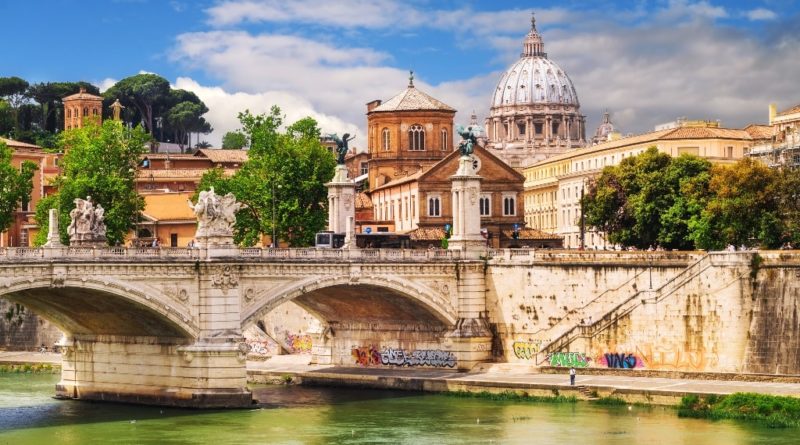The richness of Italian civilization incorporates history and heritage through art, architecture, and gastronomy acting as a celebration of culture with unquestionable inimitable style, endless feasts, and sensational landscapes. Sacred sites and medieval villages, lavish churches, and scenery imitating art, the ambiance of Italy derives from a fantastical culture basking in the daily revelries of life, from a simple sip of espresso to the aromas of a slow cooking stew.
Exploring Italy takes you face-to-face with icons of Western Civilization, such as the Colosseum and the Leaning Tower of Pisa, to witnessing expressions of the soul in the works of Leonardo da Vinci’s The Last Supper, Michelangelo’s David, or Botticelli’s The Birth of Venus. Playful baroque fountains grace the public piazzas of Rome, and elegant statuary adorns the nave of the Sansevero Chapel in Naples. The trails of the past take you past the Roman empire to the Greek settlements of Southern Italy and Sicily or along the famous pilgrimage route of Via Francigena, which connected France to Rome during Medieval times.
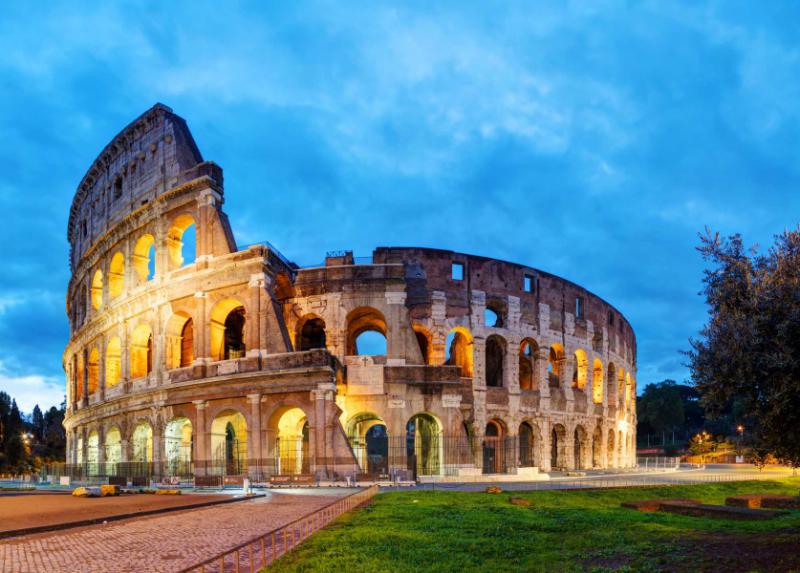
Luxury, wonder, and adventure cross paths around the Italy’s more than 116,000 square miles, featuring over 4,700 miles of coastline along the Adriatic, Ionian, and Tyrrhenian seas. The fascinating preservation of Italy’s past has attributed to the nearly 50 different UNESCO World Heritage sites scattered around the Italian peninsula. The diverse landscape and captivating wildlife of Italy escape the awareness of visitors interested in nothing more than capturing the culture of the main three cities of Rome, Florence, and Venice, however, Italy’s treasures go beyond the beauty inside the preserved historical centers of villages, towns, and cities across the peninsula by protecting its varied scenery spanning the arid plains and craggy gorges of the south, rolling lush hills at the heart of Italy, and snowcapped peaks of the Dolomites and Alps in the north.
The remarkable history of civilization in Italy dates back to the 18th century BC, but the history of the unified country began in the 1860s during the Risorgimento, during which time Vittorio Emanuele II, king of Sardinia liberated the territories of Italy occupied by the French, Spanish, and Austro-Hungarians. The Republic of Italy is even younger, beginning after World War II and the end of Mussolini’s fascist regime.
The aftermath of the Second World War left Italy with a shattered economy and divided society. The king, Vittorio Emanuele III, abdicated the throne and the new king, Umberto II, called for a Constitutional Referendum, which ended the Italian monarchy by placing a republic in its stead by mid-year 1946. The post-war economic growth cooled by the early 1970s and has since rebounded only in popular tourist destinations and the industrial cities of the north.
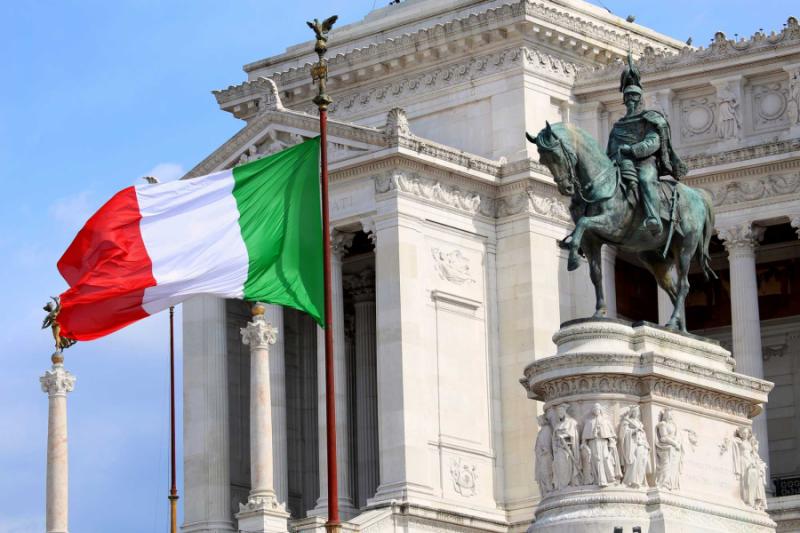
Even the most curmudgeonly of people fall in love with Italy’s distinctive pace, which changes between the rush of the cities to the quiet streets of towns and the peaceful ambiance of hillside villages. Even the atmosphere shifts between North, Central, and Southern Italy, emanating from enchanting aromas, delectable wines, and a slower pace of life. The Mediterranean peninsula captures the importance of Western European history in the way it shaped the greater continent and the world measured against the natural history of the landscape.
Great roads, accessible airports, and consistent ferries make even the most remote destinations of Italy reachable for a full-fledged romantic escape, unforgettable family vacation, educational sightseeing tour, or a simple Italian retreat to satisfy your curiosity. Your introduction to Italy provides easy access to all practical information regarding visa questions, steps to pre-trip healthcare, and the variety of activities and must-see destinations. Explore the famous, infamous, or hidden wonders across the Italian Peninsula and islands, indulging in the excitement of your Italy vacation to come.
For centuries, Italy has been one of the most popular destinations for discerning travelers: a fact that’s undoubtedly linked to its rich history and cultural attractions. This is a country that saw the birth of the Renaiss anceand the spread of the Roman Empire; that has produced profound poets and legendary leaders; that boasts some of the most breathtaking scenery on Earth. It’s home to some of the world’s greatest cities – Florence, Venice, Rome – as well charming and bucolic towns and villages. Throw in a beloved cuisine and some of the friendliest people you could hope to meet, and it’s no wonder that Italy continues to draw people in – as it has for centuries.
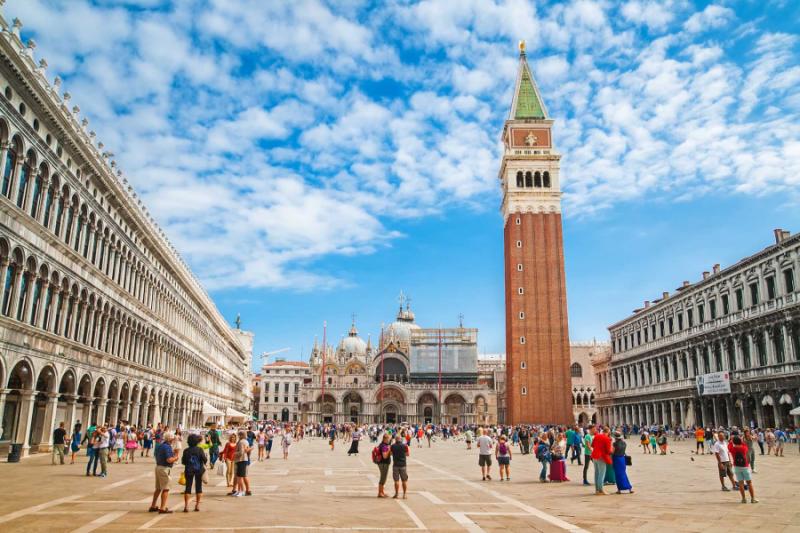 Photo: Photo of Piazza San Marco with the Basilica of Saint Mark
Photo: Photo of Piazza San Marco with the Basilica of Saint Mark
A relatively small country (it’s less than half the size of Texas!), Italy is so filled with cultural and natural treasures that UNESCO conferred it with 49 World Heritage Sites – more than any other country in the world.
First-time visitors can sometimes be overwhelmed by the sheer breadth of choices that Italy has to offer, flustered by the vast range of attractions in every corner of this captivating country. Wherever you choose to go, your tour of Italy will surely leave lasting memories. Nonetheless, there are some places that you simply cannot afford to miss, such as these cities:
- Italy’s famed and cosmopolitan capital, Rome remains one of the great European cities more than two thousand years after its founding. The Roman Forum is a stirring sight, as are the fabulous marble fountains and elegant piazzas that symbolize the more modern sections of this stylish city.
- Vatican City is the world’s smallest sovereign state and home to some of the greatest art and architecture in the Western world. The residence of the Pope and the center of Roman Catholicism, its legendary attractions are sure to leave you breathless – from St. Peter’s Basilica to the incredible Sistine Chapel.
- There is truly nowhere on Earth quite like Venice, the fabled ‘Floating City’ that has enchanted visitors of all stripes for centuries. Here, you can shop for fine glass and handmade lace on the Rialto Bridge, sip a refreshing Bellini at Harry’s Bar, and enjoy the sunset over the Adriatic from a cafe on the banks of the Grand Canal.
- The capital of Tuscany and the birthplace of the Renaissance, Florence offers a stunning array of museums, churches, art galleries and restaurants that are sure to delight. The art scene here is justifiably famous – the Uffizi Gallery is one of the best in Europe, and the Accademia houses Michelangelo’s magnificent David – but history buffs, gourmands and shopaholics will also relish this spectacular city on the banks of the River Arno.
- Milan is the second-largest city in Italy and the home of some of the most celebrated fashion designers and haute-couture houses in the world. It’s a vibrant city of fine living and high culture, from the glittering boutiques of Via Montenapoleone to the hallowed halls of La Scala – one of the world’s most renowned opera houses.
UNIQUE EXPERIENCES
Italy isn’t a place that you visit, it’s a place that you experience: touching all of your senses, engaging your emotions, in a way you never thought possible. While many might choose to walk the streets of the country’s historic cities or simply relax in its postcard-perfect countryside, these are a few special attractions that cannot be found anywhere else:
- Take a tour through the seven miles of galleries that make up the Vatican Museums, as an erudite guide introduces you to some of the greatest artworks in human history. You’ll be regaled with stories as you feast your eyes upon the stunning frescoes of Raphael, the sublime watercolors of Titian, and to cap it off, the inimitable beauty of the awe-inspiring Sistine Chapel.
- Explore the sun-dappled vineyards and medieval hill towns of Tuscany, one of the country’s most diverse and evocative regions. You’ll marvel at some of the world’s most venerated architecture: from the stately villas of Palladio (the West’s greatest architect) to the iconic tilt of the Leaning Tower of Pisa; from the soaring Duomo in Florence to the graceful Campo in Siena.
- Immerse yourself in Italy’s centuries-old culinary heritage in Bologna, the gastronomic heart of the country, as you learn all the tricks of the trade in a true Italian kitchen. You’ll make pasta, antipasto, main dishes, and classic desserts – then sit down to enjoy them at a family table with a fine glass of local wine or one of the succulent national liqueurs, like Amaretto DiSaronno from Lombardy or Campari from Milan.
- Explore Venice in timeless fashion as a charismatic gondolier captains you through the city’s labyrinthine canals in a sleek, jet-black gondola. Whether cruising by grand piazzas and famous landmarks, or through some of the quieter Venetian neighborhoods, this is an incurably romantic experience that is sure to leave indelible memories.
Weather and When to Go
There is no singular best time to visit Italy. Each season represents something unique and different about the landscape, culture, and traditions to create alternate experiences. The weather changes the colors of the countryside between spring and autumn, while the festivities in the cities change between summer and winter. Traditionally summer has the most popular time to visit Italy, with schools in the United States, Canada, and the UK dismissed for vacation.
But the crowds of summer offer diminishing returns in the most popular cities and towns, making it hard to explore, experience, and discover. Wait times at the museums reach hours long, and actual locals leave on holiday from mid-August, coinciding with the Catholic calendar and the Feast of the Assumption of Mary, to the first of September. But Italians do not disappear from Italy during the height of summer, with the peak of the travel season offering a stunning impression of local life in smaller communities and the popular resort getaways in the south or the cooler alpine climates in the north.
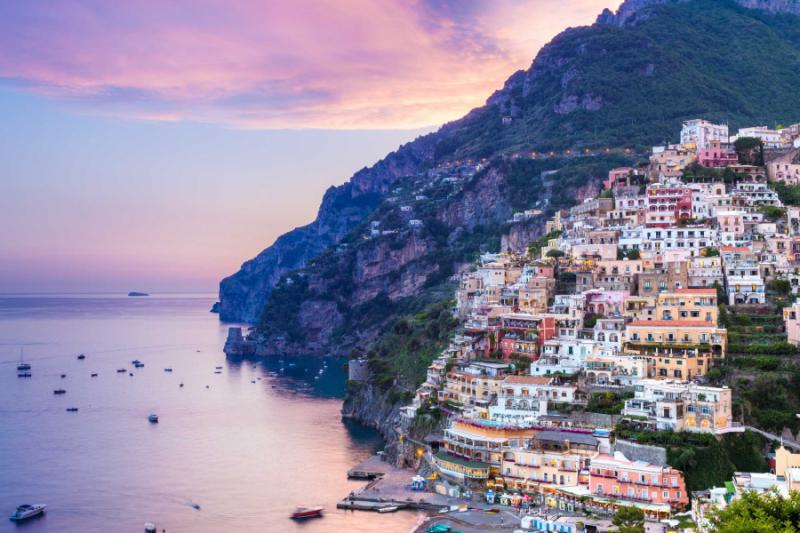
An Overview of Italy’s Seasons
There are little surprises to Italy’s weather systems, which is considered the four seasons of the European continent. The winter brings cold weather and snow in the north, especially in the mountainous landscape separating Italy from France, Switzerland, and Austria, along with the Apennines along the bordering regions of Tuscany and Emilia-Romagna. The moisture of Northern Italy causes abundant rainfall throughout the year, most prominently during the summer months with precipitation average 40 inches per year, adding to the winters during which snow blankets the mountains.
The weather systems of Central Italy provide a milder shift between summer and winter, with a shorter and less intense cold season than northern Italy. The summers linger in Central Italy without the balminess of the mountains. The refreshing sea air helps mitigate the humidity around most of the central regions. Temperatures around Rome can reach over 100 degrees Fahrenheit during July and August, but average a high of 86 degrees Fahrenheit in Tuscany. Rain falls mostly in the winter, as opposed to Northern Italy’s summer months, providing an annual precipitation between 31.5 and 33.5 inches.
Southern Italy boasts the popular Mediterranean climate for which Italy is most known, averaging temperatures of 77 degrees Fahrenheit in in July, shaping the hot, dry and long southern Italian days. Rain in the southern regions fall during autumn, winter, and spring, averaging between 19 and 23 inches a year. The southern coasts of Sicily and Sardinia are the driest areas of Italy. However, the mild seasons of the Italy’s southern regions provides navigable climate year-round.
The climate throughout Italy varies by regions and seasons. The northern part of the country generally experiences longer, colder winters and more mild (but more humid) summers than the south. For instance, in a northern city like Milan, the temperature can get down to the 20s during December and January. A southern city, like Palermo, can experience 90s in the months of July and August. The central regions of Italy – Tuscany, Umbria and Lazio, for instance – commonly have the best weather regardless of the season: you’ll be spared the heat of the south and the greater likelihood of rain in the north.
TUSCANY

The Best Time to Visit Italy
Italy consistently ranks as one of the most visited countries in the world, rich in ancient history, magnificent art, and natural beauty. The best time to visit Italy is based on the types of activities you wish to pursue and the different areas of Italy you choose to explore. The cool waters of the Adriatic Sea will feel rigid if dipping your toes into the tide in winter instead of summer. The lush greenery and blossoming wildflowers of the alpine pastures in the Dolomites strike a profound contrast to the expectant reflective white of blanketing snow when staying in a ski during summer instead of winter.
Those who can travel to Italy outside of the “Peak Season” should, but remember, other travelers have the same concerns as you and hope to get the most out of their time in Italy with the least amount of hassle. Witnessing Leonardo da Vinci’s The Last Supper or Michelangelo’s Sistine Chapel is a majestic experience. Standing up close to these masterpieces of western artwork allow you to view the intimate details photographs can’t capture, making you feel part of the work. That feeling of enchanting and gratitude disappears when surrounded by ten tour groups with chatty tour guides and other members who pass through the galleries taking pictures but otherwise not staying long enough to view the artwork away from the camera lens or phone screen.
Visit the fascinating statue of the Veiled Christ in Cappella Sansevero in Naples, and you feel as though you have the majestic work and the chapel to yourself. Tour the Colosseum in Rome at the beginning of August, and you might feel like a gladiator trying to wrestle free from the crowd; take a photo without featuring a tour guide’s umbrella, an idling bus, or strangers lingering near the entryway.
The peak travel seasons in Italy are late spring to early summer, and early autumn. Normally, many prominent attractions will be busiest in May and June, so the best time to go to the best-known destinations – Florence, Venice, and Rome – is either in Aprilor in October. However, smaller towns and more rural areas are generally less crowded even in the height of the season, which makes for a nice option in those months when the major cities are packed with tourists from around the world.
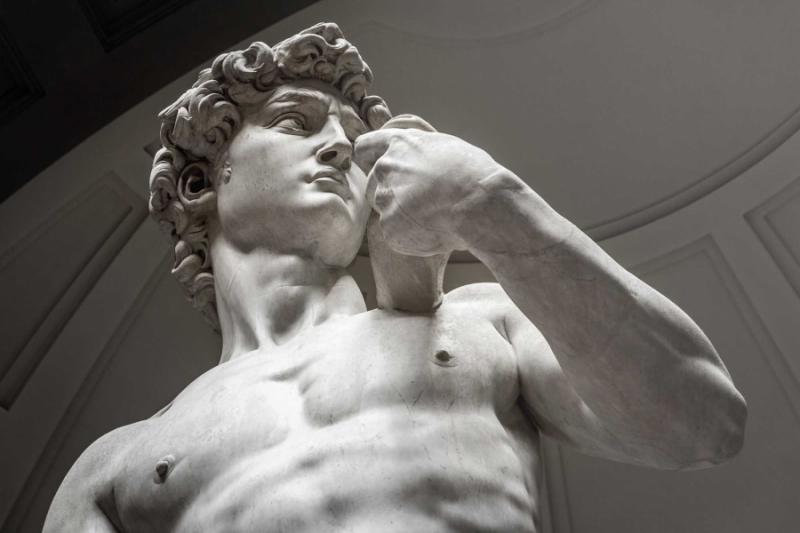 Photo: David by Michelangelo, Florence
Photo: David by Michelangelo, Florence
There are a number of great places to visit in Italy during the winter. Skiing is excellent in the north – the Dolomites and Alpine regions. Southern Italy (regions like Puglia, Campania, Sicily and Calabria) is generally quite pleasant in the early and late parts of the year. It’s not unusual for Milan, in the north, to see snow while Palermo, in the south, can be in the 70s on the same day. Early March can be rainy (Venice, Cinque Terre, etc.) but the biggest and well known cities start to clear up in late March or early April: this is the time to visit, before the influx of tourists come to experience the brilliant months of May and June. Christmastime brings a number of beautiful and unforgettable festivals and traditions throughout the country, though you’ll find the weather in the southern and central regions usually less harsh than in the north. The winter months are also the best time to visit for budget-conscious travelers, allowing you the chance to engage with Italy’s splendid cultural scene without the burden of large crowds.
Is There a Perfect Time to Visit Italy?
While hotels might offer deals or tour groups promote packages, there is no perfect to visit Italy. Rome does not stop as a popular destination outside of summer, nor do locals in Venice suddenly welcome you into their homes because you are the single visitor to the lagoon in winter. The different times of year simply provide different experiences. The winter does not always mean the water along the southern shores of Italy is too cold to swim in, while the summer doesn’t mean you can trek the plains and mountains of the Italian Alps without caution.
Life in Italy has endured for over two millennia and will continue to feature history, culture, and natural wonderment rain, snow, or shine. Instead of the familiar four seasons of summer, winter, spring, and “autumn, there are only three seasons that matter when traveling to and around Italy: low season, shoulder season, and high season.
The High Season
Although summer is the best season for many people, especially families, to visit Italy, tourists on similar schedules–those shaped mainly by their child’s school system or the two-week vacation calendar their job allows them–crowd the main cities of Rome, Florence, and Venice. Italians take their vacation between August and September, with local shops closing during the holiday, leaving mostly tourist shops open between August 15th and as late as September 15th. The air in August across much of Italy grows humid and muggy, made worse by the tight crowds filling piazzas and narrow cobblestone streets.
Hotels and restaurants mark up their prices as a premium for staying home while their neighbors take a break on the coast or in the mountains. Less-visited cities, such as Turin and Milan, feel like ghost towns compared to the major attractions of Venice, Rome, and Florence, with fashionable restaurants and popular nightspots closed for the entire month. In these less-popular destinations, hotels often offer a discount during August, with the largest crowds passing through the popular triangle of cities between May and July. There are also various festivals in specific towns across Italy held during summer that are fun and unique experience in which visitors can take part, including, but not limited to, the Palio horse race in Siena and the Opera Festival in Verona.
Apart from the main season of summer, prices and crowds skyrocket at certain times of the year, mainly Christmas, New Years, and Easter, when Italians also like to vacation for the holidays and spend time with their families. When traveling to Italy to ski the Alps and the Dolomites or spend time in the snow, High Season begins in late November and ends in early March, consistent with the snowfall along the northern borders.
The Low Season
The low tourist season represents the opposite of the crowds and long lines of the High Season. Summer resorts along the Adriatic and Tyrrhenian Seas have closed their doors. Family-run hotels and smaller seasonal museums shut down as well. Low Season provides the perfect opportunity to experience the cultural events of larger cities, such as touring popular museums, archeological sites, medieval towns. It is the best time to explore the canals of Venice, without the maddening packs of people clogging the waterways with gondolas.
It is also a great way to visit the Galleria dell’Accademia to see Michelangelo’s David or traverse the halls of the Uffizi, both located in Florence. Fewer people mean less time waiting in line and provide ample opportunities to interact with locals in Italy, whether dining in a stylish trattoria in Padua or sampling cheese in a salumeria in Napoli.
The colder air also makes the sporadic crowds of Rome more bearable, but keep in mind, the metro system in Milan and Rome do not have air conditioning. When exploring the major cities by foot and utilizing the public transportation, you will notice locals wearing gloves, scarves, and heavy coats outdoors and inside the trains, which creates sweltering body heat in the non-air-conditioned train cars during rush hour. From certain perspectives, visiting Italy in Low Season is ideal. The cities are quieter, the lines are shorter, and you can have the chance for a more immersive Italian experience.
The Shoulder Season
The shoulder season flanks both low and high tourist seasons, encompassing spring and autumn, mainly from April to June and September to October. The large crowds generally depart Italy early September to return home, while the summer resorts in the south remain open until mid-September. It is also still warm enough to enjoy the beauty of the famous shorelines and towns of the Amalfi Coast or Cinque Terre before the cold sets in.
The main festivals of the regions begin in spring coinciding with cultural celebrations, produce cultivation, and religious events. The fall ushers in the favored grape harvest across much of Northern and Central Italy. Temperatures remain cool in both spring and autumn, while the colors of the landscape change from winter white to emerald green, or from the lush summer landscape to a shimmering tawny and burnt sage.
Every October Perugia celebrates chocolate with a week-long festival and Bari pays homage to the harvest with a food festival dedicated to vineyards, olive groves, and the season’s bountiful culinary pleasures. The Shoulder Season provides a stable amount of tourists across the country with many visitors focusing on the three most popular destinations of Rome, Florence, and Venice. This is still the best time to visit these major destinations, along with the various regions of Italy.
If you prefer a beachside getaway, you should visit Southern Italy or wait until the warmer months of summer, as the weather and water will not be warm enough in the Northern or Central Italy until late May, cooling by early September. You could enjoy the serene gold sands and warm water lapping against the southern edges of the country as late as early November, depending on how far south you choose to travel.
WHERE TO STAY
Nothing will heighten your Italian experience like the perfect hotel, and Italy has a huge range of accommodation that is as eclectic and exciting as the country itself. Families will revel in the condo-style hotels that can be found off the winding canals of Venice, or the charm of a private villa deep in the hills of Tuscany. Couples will cherish the romance of a cliff-hugging suite near the Blue Grotto of Capri, and rave about that quaint hotel room right next to that incredible pizzeria and the sprawling Spanish Steps. Nor do the options stop there: you can step into the Renaissance splendor of a former castle, indulge in bubbly and room service at a posh Rome hotel, or charter a luxury motor-yacht to cruise along the Amalfi coast.
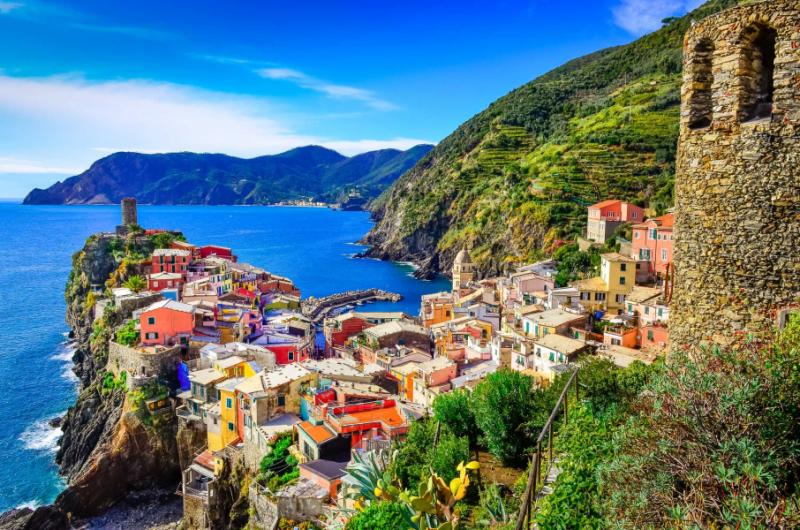 Photo: Scenic view of the colorful village of Vernazza, Cinque Terre
Photo: Scenic view of the colorful village of Vernazza, Cinque Terre
There are also, of course, a number of international hotel chains with an extensive presence in Italy – offering you all of the comforts and familiarities of home while you’re an ocean away. Be advised that rooms in European hotels tend to be smaller than their American counterparts, and many older hotels in the country do not have elevators to the higher floors. When considering a particular type of hotel, it’s wise to remember that room sizes in Italy tend to be smaller than those of an equivalent rated American hotel.
The Quality of Accommodation
Boutique and eco-lodges have become popular in Italy over the years, along with luxurious villas, elegant castles, and even quiet monasteries. The travel industry has moved away from the bland accommodations and brand names of the past, revealing dedication to quality, distinctiveness, and fashion to make your accommodations in Italy part of the travel experience. Brand hotels, such as the Marriott or Hilton, the Ritz Carlton and the Four Seasons are names affiliated with grandeur and luxurious rooms. The most common brand hotels in Italy are Jolly and Hilton. However, smaller boutique hotels have created a movement capturing the leisure and Italian culture tucked in behind hidden bakeries and along private palaces. There are approximately 40,000 hotels in Italy, each with a fixed price in association with the Provincial Tourist Board.
The ways in which grand hotels now have distinctive designs more connected to their locations is a symbol of the effort’s strength, which demanded unique style inspired by tradition, history, and heritage from the local furnishings to particular colors often associated with royalty or the former aristocracy. Erecting new structures in the heart of a historic city can be challenging, necessitating accommodations to use what was readily available, following in the longstanding tradition of renovating to upgrade the state of antique, and in some instances derelict, buildings or renovating and retrofitting seasoned edifices in need up updating but not major repairs. Ingenuity accompanies style in design, with different private hotel owners finding ways to personalize their accommodations, reflecting a region, town, or city more than the elusive culture of Italy.
It is easy to imagine four- and five-star quality lodges decorating the landscape of Italy, both in the cities and across the rural expanse. From mountain lodges in the Alps to seaside resorts overlooking the Adriatic or the Mediterranean, you are unlikely to find an ironing board in your room, and you will most likely open the door with an actual key as opposed to an electronic swipe card. In older hotels, the bathrooms can be narrow, but the windows in the bedrooms look out to the bustling life of the city, providing the soundtrack of daily life adding to the historic charms of the accommodation and its setting along cobblestone streets or olive groves, undulating hills or vineyards.
When contacting an accommodation, you should always hold onto an email or receipt of confirmation for your reservation. If you have traveled to a hotel without a reservation, it is considered normal to ask to see a room before booking. Italy has a variety of names for their accommodations across the country, with some words strictly in Italian. There are also six classifications for accommodation in Italy ranging from 1-star to 5-star deluxe, which is considered the very best. This guide can help you better understand the different types of lodgings you might prefer when traveling through Italy.
Hostels
The common travel accommodation is a great way to save money across Europe and the world. The Italian name for a Hostel is ostello. They often have dorm-style rooms, along with rooms for couples or individuals. These rooms often still share a common bathroom with the other rooms on a given floor. A hostel can also call itself a hotel in Italy. Just because a lodging has the word hotel does not mean it will be the fanciest or most luxurious establishment. However, hostels do remain popular amongst international travelers on gap years, university students, and those looking for cheaper accommodation options during their travels through Europe.
Agriturismo
In English the term translates to “farm holiday,” however, in Italian the word has a much deeper meaning. The accommodation is located on a working farm with experiences ranging broadly across the country. Options for low-budget travelers often include working on the farm to subsidize accommodation, while other visitors can enjoy the unique qualities of the rural landscape through hiking, cycling, or cooking classes for insight into life, culture, and the traditions of Italian farmers. Agriturismo could also mean staying on an olive estate or vineyard, with some properties providing enchanting and lavish grounds for their clientele to enjoy outside of the major cities and towns.
Bed and Breakfast
The term Bed and Breakfast has become more popular in recent years in Italy’s hotel industry. While the words conjure a warm image of countryside cottages or seaside bungalows, Bed and Breakfasts in Italy do not always fit the same criteria. Many of these types of accommodations serve traditional Italian breakfast in the morning, which consists of espresso and a pastry. This meal often leaves non-Italians desiring eggs, bacon, or traditional dishes of a breakfast from western English-speaking culture. The accommodations themselves are of good quality, with fresh flowers decorating the room and a cocktail welcoming guests upon their arrival. In Italy, a Bed and Breakfast could be viewed as a guest room located in a private home, as well as inside a working villa or an apartment.
Convents/Monasteries
The religious grounds have long histories of serving as hostels for traveling pilgrims or knights searching for a bed for the evening. The tradition continues in many monasteries and convents across the Christian world, especially in Italy, with the historic edifices offering inexpensive options for tourists or glamorous stays on refurbished grounds now housing elegant accommodations. Staying at a working monastery or convent can shape your experience through exposing you to the same type of rules and regulations to which monks and nuns are subjected. The doors to the grounds are locked at a certain hour, instating a curfew. Separate sleeping quarters are imposed on men and women regardless of their marital status. The grounds are safe, quiet, and offer a distinctive understanding of monastic life that has remains unchanged for centuries.
Hotel/Albergo
The words are interchangeable in Italy, with some accommodations using one, the other, or both when advertising to visitors. The star system in Italy can vary more wildly than what you may be accustomed to while traveling. The amenities a hotel has differs not only between stars but between cities, towns, and villages. Options like elevators, air conditioning, and gyms depend upon the age of the building, with more lavish amenities common in larger cities such as Rome, Venice, or Florence.
Swimming pools are common at hotels in the countryside where space is not an issue. The star rating is not as standard as would suggest from other countries. 1- and 2-star properties may not be substandard and are instead smaller, family-run inns brimming with character and friendly owners eager to help perfect your travel experience. Their rating could be due to a lack of Western-English style amenities, such as an elevator or American breakfast. 5-star hotels will offer the types of amenities and comforts for which travelers familiar with American or English standards will expect and appreciate.
Villas/Palaces
There are different ways to appreciate the villas and palaces of Italy. Many former aristocratic mansions or estates have been renovated and revitalized as private accommodations. While some villas provide unique rental opportunities, similar to renting an apartment or vacation home, others fit into the category of hotel. The most common place utilizing former palaces as hotels is in Venice, where images of the Republic continue to decorate the elegant halls and grand lobby, leading to enchanting rooms overlooking the quiet canals. A region popular with tourists for renting private villas is Tuscany, providing a base to make day-trips into the surrounding countryside to visit the medieval villages.
Castles
Staying in a castle is also an option when visiting Italy. The accommodation is also considered a hotel but offers a unique perspective on the ways in which Italy has transformed its history for contemporary use while simultaneously representing its heritage. The types of castles range from 14th-century masonry reminiscent of a storybook overlooking a small town to 11th-century strongholds in the countryside in view of lush vineyards. The architectural style and age of the castles depend on the region in which the edifices are located, providing fabulous insight into the different families that shaped the various regions of Italy, promoting the distinct cultures connected more to the former city-states than to the country as a whole.
Camping
What was once considered a rustic alternative to hostels or luxury hotels has become a luxury excursion in its own right across the world. The word “glamping” embodies the beauty of the countryside, the quiet of rural life, and the luxury of a five-star hotel. A variety of campsite around Italy provides shuttles to the nearest city throughout the day for visitors to tour monuments and culture while still reveling in nature and comfort. Glamping is gaining in popularity due to its ability to combing discovery and seclusion, comfort, and nature with accommodations ranging from elegant tents to gorgeous bungalows, quiet lodges to fascinating caves, and even treehouses and yurts.
ITALY TOURS: THE ALL KENYA WAY
Zicasso matches you to top travel specialists working to plan you dream vacation, allowing you to tour Italy through the conservation of historic sites, giving new life to cultural heritage and traditions, or basking in the Mediterranean sunlight on the Riviera or southern coastline of the Western European peninsula. There is more to traveling in Italy than the ruins of Rome, the art in Florence, and the canals of Venice.
Many travelers think that they have to choose between a pre-packaged group tour versus self-planned independent travel. The former offers hassle-free convenience while the latter offers flexibility. However, we recommend a third option: Customized tours of Italy.
With this option, you have the best of both worlds and you’ll enjoy a variety of unique and authentic experiences on a handcrafted Italy itinerary, customized just for you. You’ll travel independently, but your trip will be carefully planned for you to ensure hassle-free logistics, perfect hotel selections, and most importantly, authentic experiences that are most meaningful to you. For example, food lovers can have their trips designed around the foods of Italy or explore Tuscan cuisine in one of Zicasso’sTuscany tours. If you’re interested in discovering an eclectic world of Italy, our Sicily tours section offers a wide range of ideas. Or if you’re into art and fast cars, or any unique combination of special interests, your trip can be designed accordingly.
While the major cities on the Italian Peninsula provide the staples of understanding Italy’s beauty, traveling the Zicasso way takes into account the aromas, tastes, and colorful charms waiting around every corner of an historic village or along the hidden museums of a bustling city, whether with unseen natural wonders, lavish ski and beach resorts, or cultural experiences taking you into the homes of a life-long chef. An Italy tour with Zicasso allows you to experience all the must-see sights, including those destinations you had never thought of or never before knew existed.
All you have to do is tell us about your dream trip by writing to:
tours@all-kenya.com

